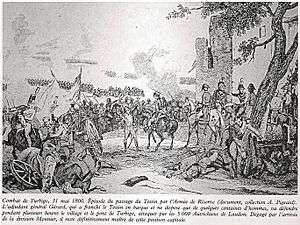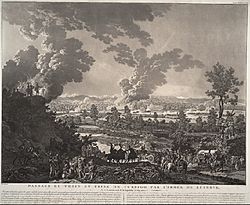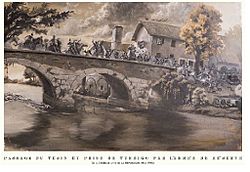Combat of Turbigo facts for kids
Quick facts for kids Combat of Turbigo |
|||||||
|---|---|---|---|---|---|---|---|
| Part of the War of the Second Coalition | |||||||
 Combat of Turbigo |
|||||||
|
|||||||
| Belligerents | |||||||
| Commanders and leaders | |||||||
The Combat of Turbigo was a battle that happened on May 31, 1800. It was part of a bigger conflict called the War of the Second Coalition. This fight took place in a town called Turbigo in Italy. It was between the armies of France and Austria. The French soldiers had just traveled a long way, crossing the Alps mountains from Piedmont.
Contents
Why the Battle Happened
On May 30, 1800, French soldiers from the Boudet division arrived in Novara. On the same day, General Duhesme positioned his troops along the Ticino river. One group, the Boudet division, was near Trecate. Another, the Loison division, was in Vigevano.
On May 31, 1800, Napoleon Bonaparte was in Novara. Napoleon was the leader of France at the time, known as the First Consul. He decided to take advantage of the Austrian army's uncertainty. He quickly moved his army towards the Ticino river.
Crossing the Ticino River
On May 31, Murat, a French general, led his troops across the Ticino river. Napoleon himself watched this important crossing. At the same time, General Duhesme also began to cross the river nearby. Murat's leading soldiers were already in Galliate early that morning.
The Austrian soldiers were on the other side of the Ticino river, facing Galliate. They had strong defenses and many cannons. When the French started firing, the Austrian cannons immediately fired back. The French had only two small cannons, but they were very effective. These cannons were used by special guards, with Napoleon watching closely. They helped the French infantry (foot soldiers) cross the river. The French used rafts and a few boats they found. This strong support forced the Austrians to leave their defensive spots by the river.
Fighting in Turbigo
After leaving the river, the Austrians quickly regrouped. They set up defenses at a bridge over the Naviglio Grande canal, right at the entrance to Turbigo. They built many barricades on the bridge. Meanwhile, the Austrian general Johann Ludwig Alexander von Laudon arrived in Turbigo with many more soldiers, especially cavalry (soldiers on horseback).
Even though the Austrian position was strong, the French attacked it. The Monnier division, with the 70th demi-brigade leading the way, charged forward. Many soldiers from the 72nd demi-brigade also joined them after crossing the river.
The Austrians lost 700 men in this fight. About 400 of them were taken prisoner. General Guénand, another French leader, positioned his soldiers in front of Turbigo. The Austrians tried several times to get back control of the bridge with their cavalry. But all their attempts failed. More than 300 Austrian cavalry soldiers were lost.
During this battle, a soldier named Jacques Baptiste Louis Morin was hurt in the arm. Napoleon himself saw his bravery and promoted him on the spot. Another soldier, Jean Pierre Lanabère, later became a general. He bravely died in a battle in Russia in 1812.
By 10 PM, the town of Turbigo was completely burned. It finally fell into the hands of the French army. The French were tired, so they couldn't chase the retreating Austrians right away. French soldiers spent the whole night searching Turbigo, house by house. They wanted to make sure all Austrian resistance was gone.
On June 1, Napoleon Bonaparte was in Turbigo. Earlier that morning, while still in Novara, he wrote to General Lannes. He told him about the victory at the Ticino river.
After the Battle
On June 2, Napoleon woke up in Turbigo feeling more relaxed. The day before, Murat and Boudet had already started marching towards Milan. Murat, with all his cavalry, moved very quickly to catch the enemy. But the Austrians had fled towards Milan so fast that he couldn't reach them. Murat's chase ended at the city gates of Milan. The city surrendered without any more fighting.
On June 2, 1800, at 2 PM, Napoleon Bonaparte left Turbigo in a carriage. He entered Milan triumphantly with his advisors, Petiet and Bourrienne.
Interesting Facts
Another battle also took place in Turbigo in 1859. This was during the Second Italian War of Independence. It was also fought between the French and the Austrians, and it's known as the "Battle of Turbigo".
In Turbigo today, there is a museum. It has information and items about the events of the 1800 battle and the crossing of the Ticino river.



